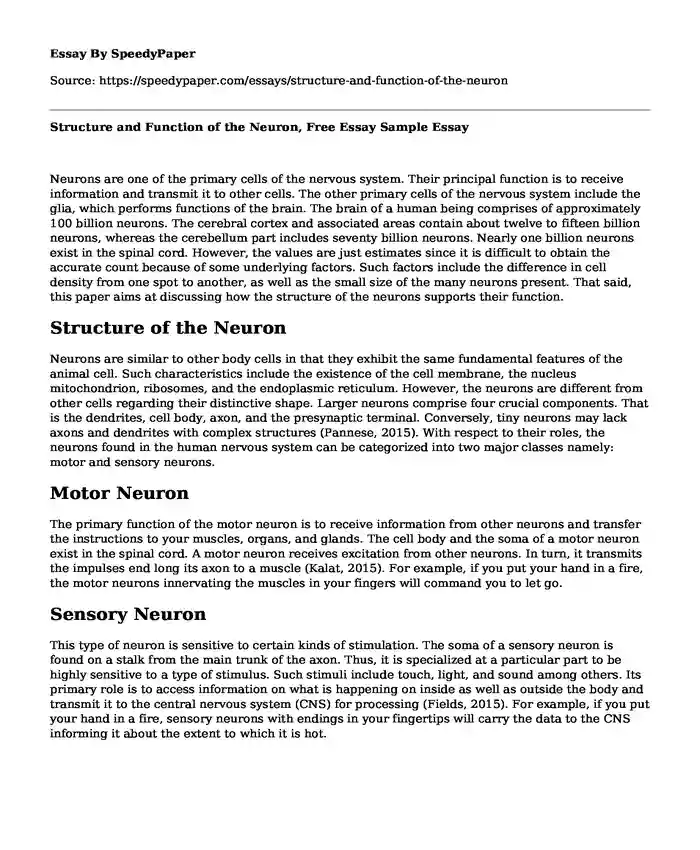Neurons are one of the primary cells of the nervous system. Their principal function is to receive information and transmit it to other cells. The other primary cells of the nervous system include the glia, which performs functions of the brain. The brain of a human being comprises of approximately 100 billion neurons. The cerebral cortex and associated areas contain about twelve to fifteen billion neurons, whereas the cerebellum part includes seventy billion neurons. Nearly one billion neurons exist in the spinal cord. However, the values are just estimates since it is difficult to obtain the accurate count because of some underlying factors. Such factors include the difference in cell density from one spot to another, as well as the small size of the many neurons present. That said, this paper aims at discussing how the structure of the neurons supports their function.
Structure of the Neuron
Neurons are similar to other body cells in that they exhibit the same fundamental features of the animal cell. Such characteristics include the existence of the cell membrane, the nucleus mitochondrion, ribosomes, and the endoplasmic reticulum. However, the neurons are different from other cells regarding their distinctive shape. Larger neurons comprise four crucial components. That is the dendrites, cell body, axon, and the presynaptic terminal. Conversely, tiny neurons may lack axons and dendrites with complex structures (Pannese, 2015). With respect to their roles, the neurons found in the human nervous system can be categorized into two major classes namely: motor and sensory neurons.
Motor Neuron
The primary function of the motor neuron is to receive information from other neurons and transfer the instructions to your muscles, organs, and glands. The cell body and the soma of a motor neuron exist in the spinal cord. A motor neuron receives excitation from other neurons. In turn, it transmits the impulses end long its axon to a muscle (Kalat, 2015). For example, if you put your hand in a fire, the motor neurons innervating the muscles in your fingers will command you to let go.
Sensory Neuron
This type of neuron is sensitive to certain kinds of stimulation. The soma of a sensory neuron is found on a stalk from the main trunk of the axon. Thus, it is specialized at a particular part to be highly sensitive to a type of stimulus. Such stimuli include touch, light, and sound among others. Its primary role is to access information on what is happening on inside as well as outside the body and transmit it to the central nervous system (CNS) for processing (Fields, 2015). For example, if you put your hand in a fire, sensory neurons with endings in your fingertips will carry the data to the CNS informing it about the extent to which it is hot.
The Primary Roles of a Neuron
If one considers the functions of the above classes of neurons, you can generalize that all neurons have three primary roles. Their first role involves receiving impulses, signals or information. Secondly, neurons integrate the incoming command to determine whether or not the data should pass through to the intended targets. Thirdly, they communicate the information to the target cells such as the muscles, organs, and glands.
Conclusion
This paper discusses the structure and roles of the neurons. The primary types of neurons addressed include the motor neurons and the sensory neurons. Each has a distinctive feature that separates them from other cells of the body. The motor neurons, with the soma located at the spinal cord, receives signals from other neurons. On receiving the impulses, it conveys the information to your muscles, organs, and glands. The sensory neuron is sensitive to specific stimulations like touch, light, and sound. It is specialized at one end for high sensitivity to a particular type of stimulation. In general, the primary roles of the neurons include receiving, integrating and communicating impulses/signals to the target muscles, glands or organs.
References
Fields, R. D. (2015). A new mechanism of nervous system plasticity: activity-dependent myelination. Nature Reviews Neuroscience, 16(12), 756.
Kalat, J. W. (2015). Biological psychology. Nelson Education.
Pannese, E. (2015). Neurocytology: fine structure of neurons, nerve processes, and neuroglial cells. Springer.
www.youtube.com/watch?v=cUGuWh2Uemk
Cite this page
Structure and Function of the Neuron, Free Essay Sample. (2022, May 05). Retrieved from https://speedypaper.net/essays/structure-and-function-of-the-neuron
Request Removal
If you are the original author of this essay and no longer wish to have it published on the SpeedyPaper website, please click below to request its removal:
- Essay Example on the Richard Cory Poem by Edwin Arlington Robinson
- Essay Sample on Service Dogs
- Global Stratification - Free Essay Example
- Essay Example on Female Genital Cutting/Mutilation
- Japanese Anime Popular Culture, Essay Sample for You
- Creative Writing Essay: Introducing Complexia into the Market, Free Example
- Literature Review Example on the Role of Giftedness in Solving Global Problems
Popular categories





